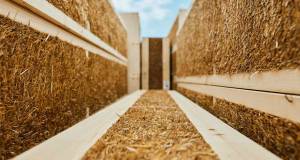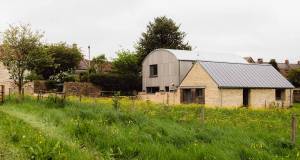
- Marketplace
- Posted
Passive Purple excels in airtightness challenge
The application of Passive Purple Liquid airtight membrane to a dilapidated test building has demonstrated the product’s remarkable ability to air seal even the leakiest structures.
This article was originally published in issue 30 of Passive House Plus magazine. Want immediate access to all back issues and exclusive extra content? Click here to subscribe for as little as €10, or click here to receive the next issue free of charge
In April, Intelligent Membranes was asked by Beattie Passive, the leading manufacturer of offsite passive house building systems, to visit the company’s manufacturing facility in Norfolk and test its Passive Purple product on a 58m3 test building that was chosen because it was expected to be very difficult to air-seal.
The test structure’s walls were of 63mm studwork with MGO board as the main fabric, with gaps of 5mm between each of the boards, and a roof of 6mm ply which had been left exposed to the elements for four years, and lost all structural integrity and shape.
The team set off by applying Passive Purple Brush to hand-fill joints and gaps, seal the service gaps and correct the split ply and warping in the roof. Next came the Passive Purple Liquid, the spray/ roll applied liquid airtight vapour control membrane, with the team making sure the building fabric was completely covered. Then came the air permeability test.
“With the test underway it was already easily noticeable that the structure was very airtight because there was zero cold air or drafts passing through the structure,” said Alex White of Intelligent Membranes.
The building was both pressurised and depressurised, and produced a test result of 0.35 air changes per hour at 50 Pascals, well inside the passive house standard of 0.6. This was particularly impressive given the thin building fabric of just 6-9mm, and the tiny size of the structure.
Next up came the smoke test, when the inside of the structure was completely filled using two smoke pellets and then pressurised to see if any smoke was escaping, with the structure proving completely airtight.
“This airtight result is what Passive Purple can guarantee on any substrate it is applied to with the backing of its BBA proven certification of 0.6 air changes per hour or under,” said Alex White. “We can guarantee the highest level of performance for our liquid applied membranes, whether it be for airtightness, waterproofing or substrate protection.”
“As long as you understand the fundamentals of airtightness, anyone can use and apply Passive Purple Liquid airtight vapour control membrane.”







